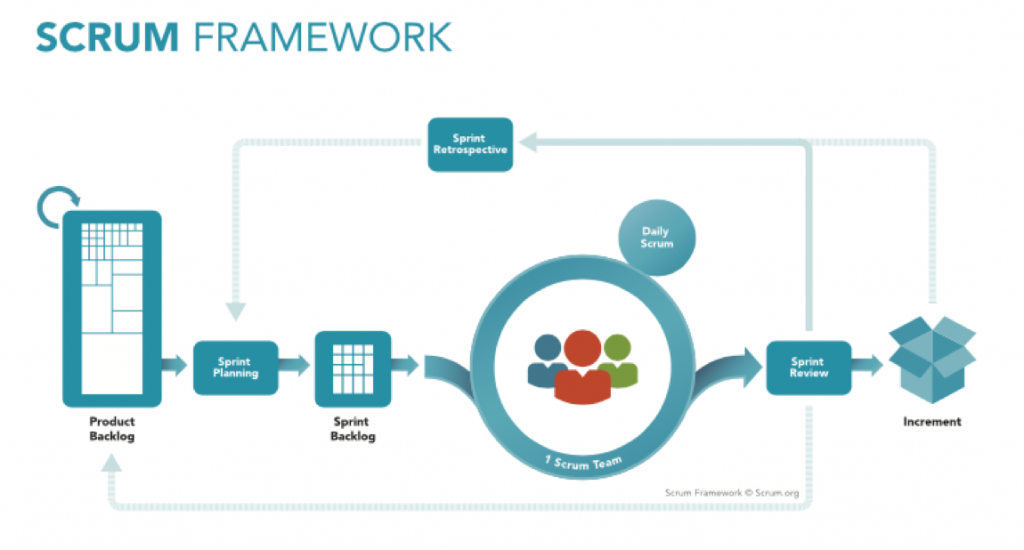The term “Scrum” was first introduced back in 1986. At the time, very few people suspected that what seemed like another buzzword would go on to blow other methodologies out of the water. And just so there is no misunderstanding: there is no shortage of other agile frameworks out there. So, what are the main reasons behind this meteoric rise?
The reasons are many and as covering all of them would take up an entire book, we will focus on the most impactful ones today.
Keeping it simple
One of the main selling points of Scrum is the fact that it has a very simple and fixed and limited set of roles, tools (artifacts), responsibilities, and events (ceremonies) that give structure to software development. For example, there are only three roles to begin with— Scrum Master, product owner, and development team.
It is actually quite interesting to find out that many Scrum naysayers mention how Scrum is too complex or rigid, when in fact it only provides a very limited number of guidelines.
Scrum has been consciously pared down to the very basic roles, responsibilities, events, and artifacts that interact so as to provide a framework for delivering valuable software. The teams are actually encouraged to build on this and to find the best ways to make Scrum work for them.

How it plays out in practice
Furthermore, Scrum increases team velocity, collaboration, and creative thinking. It equips you with everything you need in order to face practical issues and shifting requirements that arise during the project. Change is not only accepted but embraced and planned for. Meetings happen on a daily basis and progress is openly discussed. In this stage, it is common to see team leaders using visual tools such as Scrum boards and visual charts.
Scrum also values transparency over everything, allowing the entire Scrum Team full insight into how they are doing, whether there are areas in which the team can improve. Through inspection and adaptation, the team can find new ways of doing things and identify parts of the product that no longer hold any value and that can be put on hold or abandoned altogether. This significantly reduces waste in the development process.
Along the similar lines, incremental software releases also help in tackling different problems on the go. Namely, Scrum lays the groundwork for early and continuous delivery of software releases and encourages heavy user involvement. Feedback is gathered not only from end users, but stakeholders and customers as well. As a result, developers are able to assess product performance and see how well it matches market needs and expectations.
Moving out of software development
While Scrum began its life in software development, over the years, it has been applied in a number of different industries and business fields – from manufacturing to marketing, from healthcare to HR and more. In fact, if you want to run a business more efficiently, Scrum can be something that you can try out for fit.
This is enabled by Scrum’s underlying structure which is based on common sense and pure empiricism which can be applied to any kind of a team and organization. Scrum simply provides you with certain mechanisms to inspect your work and adapt how your team operates based on those findings.
In other words, Scrum is great at shining light on areas of your organization that might require improvement. This applicability of Scrum to industries other than software development has also contributed to its ever-increasing popularity.

Still not a silver bullet
It should be obvious by now that Scrum is no fad. It has an impressive track record for teams as small as several developers, but also organizations with hundreds of employees. If you do not believe us, check out a huge body of documented use cases. Likewise, note that you can tap into a whole ecosystem of standardized certifications and educational resources to overcome the learning curve. Additionally, you can take advantage of free scrum software like VivifyScrum that can help support your team.
That being said, Scrum is not for everyone. It may take a while for newcomers to grow accustomed to Scrum and those who are used to “command and control” culture are likely to find themselves on unfamiliar ground. Therefore, you need to know what you are getting yourself into (read the Agile Manifesto) and ensure this methodology suits current work styles and flows.
Conclusion
For better or worse, Scrum is the king of agile approaches. This coveted position has been secured largely thanks to a fine blend of performance and simplicity. Ready to use right away, this methodology features fixed-length iterations (sprints) and a limited set of rules. Among other things, it allows you to juggle a variety of priorities, track progress, improve collaboration, and receive invaluable feedback.
Development teams are able to exhibit a high level of flexibility and communicate openly and regularly without compromising the end result. Everyone is on the same page, has a sense of real progress, and is focused on the set goals. Consequently, the organization as a whole benefit and becomes versed in accommodating changes impediments.


